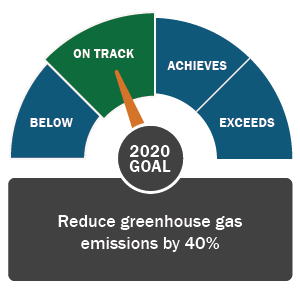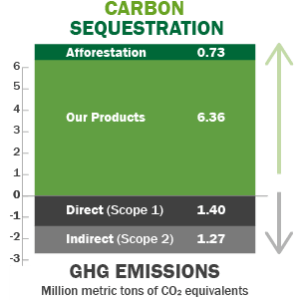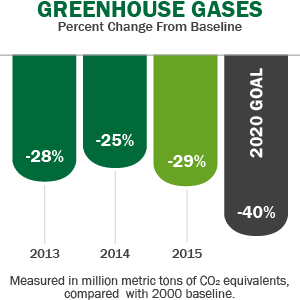Weyerhaeuser’s Forest Ecosystems: Surviving Bark Beetles and More

Weyerhaeuser’s climate change strategy is integral to its business model. Not only is the Company deeply impacted by climate change, its own operations have an enormous impact in contributing to climate change.
Forest ecosystem landscape
Forest ecosystems, which absorb carbon, are nature’s solution to the challenges posed by climate change. Extreme climate events, however, both directly and indirectly affect the sustainability of forests. Storms, droughts, and floods can damage trees, while higher temperatures and changes in precipitation can impact the formation and function of forest ecosystems. Indirect effects include the increased likelihood of “disturbance events” such as insect outbreaks due to rising temperatures. A bark beetle outbreak, for example, damaged more than 3.8 million acres of forest in the U.S. and other beetle outbreaks have resulted in the loss of approximately three billion board feet of timber in Alaska over the past three decades [1].
Effect of climate change on Weyerhaeuser and vice-versa, and measures taken by the Company
Weyerhaeuser is one of the world’s largest forest products companies, and owns and manages over seven million acres of commercial timberlands [2]. The Company grows and harvests trees and manufactures pulp, paper, lumber, wood and other building products. Weyerhaeuser’s management has continually strived to incorporate climate and weather factors into its business and operational strategy. On one hand, the Company’s timberlands are subject to the direct and indirect effects of climate change mentioned above. On the other hand, the Company needs to monitor its greenhouse gas emissions since its large manufacturing mills create a significant carbon footprint.
In December 2007, over one-third of Weyerhaeuser’s timberlands were severely impacted by a series of inclement weather events [3]. Realizing the need to improve its risk assessment procedures, the Company instituted programs to constantly enhance its geological screening process. These programs include new technologies that use geographic- and species-specific forecasting models and light detection and ranging technology to study the relationship between local and regional climate changes and long-term forest growth and yield [1]. Key findings are regularly used to optimize central planning models that aim to quantify risks by geographic region based on past trends. This ongoing climate change assessment allows the Company to be more proactive than reactionary, capturing any potential shifts in climate and the corresponding areas of potential vulnerability early.
Concurrently, the Company is also committed to limiting its effect on climate change and has committed to reducing its greenhouse gas emissions by 40% by 2020, compared to a year 2000 baseline. At the end of 2015, the Company had already reduced emissions by 29% compared to its baseline 2000 level [4]. To help achieve this target, as well as other sustainability metrics, the Company instituted a Climate Change Steering Team to guide Weyerhaeuser’s positions and goals on climate change. Additional goals included enhancing ecosystem services, managing water resources better, and adopting sustainable forestry standards [1].
Additional threats and opportunities, and analyses that can be undertaken
As Weyerhaeuser continues to maneuver through climate change, it faces a slew of additional climate change-related threats and opportunities. Threats include new proposals for carbon legislation at the federal and local levels, varying costs of energy, definitions of biomass as a renewable energy form, and other policy changes governed by regulatory bodies such as the Environmental Protection Agency and the State Department of Ecology. Opportunities include the growth in demand of renewable forest-based products, for which biomass acts as a raw material, both for existing lines of production and new product extensions, as well as the opportunity to participate in the carbon-trading markets [4].
In addition to considering issues related to its emissions profile, Weyerhaeuser should evaluate the carbon-intensity of its profits and develop analyses around the following questions. What percentage of profits is derived from products with high carbon dioxide emissions? What is the impact of climate change on raw material costs, direct costs, facility upgrade and maintenance costs? How will the risk profile impact insurance costs? How will revenue be affected by the ability to pass these costs through? What potential new pricing structures can be implemented? What is the likelihood of emissions being taxed? When would it be appropriate to enter the carbon-trading markets? What is the impact of weather patterns on revenue? [5] It is evident that Weyerhaeuser’s climate change strategy has allowed the Company to adapt its internal controls and processes, but being able to quantify the threats and opportunities creates a robust foundation for sustainable growth and development.
Word Count: 708
[1] “CASE STUDY: WEYERHAEUSER.” 2013. Accessed November 4, 2016. http://www.c2es.org/docUploads/cs-weyerhauser.pdf.
[2] “Weyerhaeuser: Timberlands.” Weyerhaeuser. 2016. Accessed November 04, 2016. http://www.weyerhaeuser.com/timberlands/.
[3] “DECEMBER 2007 STORMS.” 2008. Accessed November 4, 2016. http://weyerhaeuser.com/files/5714/2420/6339/2007_Storm_Sustainability_Report.pdf.
[4] “Climate Change & Biomass.” Weyerhaeuser. 2016. Accessed November 04, 2016. http://www.weyerhaeuser.com/sustainability/environment/environmental-footprint/climate-change-biomass/.
[5] “Competitive Advantage on a Warming Planet.” Harvard Business Review. 2014. Accessed November 04, 2016. https://hbr.org/2007/03/competitive-advantage-on-a-warming-planet.






Interesting post, it makes a lot of sense that a forest operator needs to address the impact of climate change on its operations and it seems like Weyerhauser has a well-thought-out strategy for reducing its own impact on climate change. I’m curious if there are additional business opportunities presented by climate beyond just the biomass discussion. Is there any way to sell “sustainably grown lumber” at premium prices? Could they potentially monetize some of their forests and sell them to less profit-driven organizations who want to look at carbon offsets and forest preservation in select geographies? I could see Weyerhauser trading forests in more vulnerable areas for forests in less vulnerable areas over time to allow more vulnerable areas to recover and flourish.
Great take on a topic that was more nuanced than at first blush!